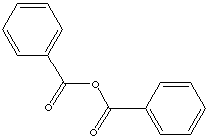PRODUCT IDENTIFICATION

TOXICITY
SMILES
CLASSIFICATION
EXTRA NOTES
PHYSICAL AND CHEMICAL PROPERTIES
Health hazard: 2, Flammability: 1, Physical hazards: 0
REFRACTIVE INDEX
EXTERNAL LINKS & GENERAL DESCRIPTION
Drug Information Portal (U.S. National Library of Medicine) - Benzoic Anhydride
PubChem Compound Summary - Benzoic Anhydride
http://www.ebi.ac.uk/chebi/ - Benzoic Anhydride
http://www.ncbi.nlm.nih.gov/ - Benzoic Anhydride
Local:
Benzoic acid, the simplest aromatic carboxylic acid containing carboxyl group
bonded directly to benzene ring, is a white, crystalline organic compound;
melting at 122 C (starting sublime at 100 C); boiling at 249 C; slightly
soluble in water, soluble in ethanol, very slightly soluble in benzene and
acetone. Its aqua solution is weakly acidic. It occurs naturally in many plants
and resins. Benzoic acid is also detected in animals. The most of commercial
benzoic acid is produced by the reaction of toluene with oxygen at
temperatures around 200 C in the liquid phase and in the presence of cobalt and
manganese salts as catalysts. It can be prepared also by the oxidation of
benzene with concentrated sulphuric acid or carbon dioxide in the presence of
catalysts. Other methods are such as by the oxidation of benzyl alcohol,
benzaldehyde, cinnamic acid; by hydrolysis of benzonitrile, benzoyl chloride.
More than 90% of commercial benzoic acid is converted directly to phenol and
caprolactam. Its use in the production of glycol benzoates for the application
of plasticizer in adhesive formulations is increasing. It is also used in the
manufacture of alkyd resins and drilling mud additive for crude oil recovery
applications. It is used as a rubber polymerization activators and retardants.
Benzoic acid is converted to its salts and esters for the use of preservative
application in foods, drugs and personal products. Sodium benzoate, sodium salt
of benzoic acid, is used preferably as one of the principal anti-microbial
preservatives used in foods and beverages (but it's concentration is limited
usually not exceeding 0.1% because it is poisonous), as it is about 200 times
more soluble than benzoic acid. Sodium Benzoate is also used in medications,
anti-fermentation additives and tabletting lubricant for pharmaceuticals. The
industrial applications are as a corrosion inhibitor, as an additive to
automotive engine antifreeze coolants and in other waterborne systems, as a
nucleating agents for polyolefin, as a dye intermediate, as a stabilizer in
photographic processing and as a catalyst. Wide range of benzoic esters are used
as solvents, dying carrier, disinfectant additive, penetrating agent and
pesticides and manufacturing other compounds.
Benzoic Anhydride, an aromatic acid anhydride, is used in synthesis of some dyes and a variety of organic compounds.
SALES SPECIFICATION
APPEARANCE
PURITY
99.0% max
0.5% max
GENERAL DESCRIPTION OF ANHYDRIDE
Anhydrides of inorganic acids are usually oxides of nonmetallic elements. Carbon dioxide (CO2) is the anhydride of carbonic acid, dinitrogen pentoxide (N2O5) is the anhydride of nitric acid, sodium oxide is an anhydride of sodium hydroxide, phosphorus pentoxide (P2O5) is the anhydride of phosphoric acid, and sulfur trioxide (SO3) is the anhydride of sulfuric acid. An acid anhydride forms an acid; a base anhydride forms a base. Sulfur trioxide (acid anhydride) reacts with water to form sulfuric acid (an acid product). Calcium oxide (an base anhydride) reacts with water to form calcium hydroxide (a base product).
Organic anhydrides contain the carbonyl group (CO). Organic anhydrides are formed by the condensation of original acids. Lactone, an internal cyclic monoester, is an anhydride derived from the hydroxyl and carboxyl radicals. In organic chemistry, most anhydride compounds are derived from corresponding carboxylic acids. Carboxylic anhydrides, general formula (RCO)2O, are the dehydration product of two carboxylic acid molecules. The name of carboxylic anhydride is given first from the original acid, followed by the separate word "anhydride". [CH3(CH2)2CO]2O is butanoic anhydride, CH3COOCOCH2CH3 is ethanoic propanoic anhydride (or acetic propionic anhydride). Anhydrides are more reactive than the parent acids. Anhydrides are typically not target molecules, but rather they are used as intermediates for the synthesis of other organic members such as esters and amides for the industrial applications include dyes, pharmaceuticals, pesticides, plastics, fibers, curing agents, plasticizers and many others. The reactivity of carboxylic acid derivatives are in order of acyl halides > anhydrides >> esters �� acids >> amides. Anhydrides react with alcohols to form esters; acetic anhydride [(CH3CO)2O] reacts with ethanol (C2H5OH) to form ethyl acetate (CH3COOC2H5) used as a common solvent. Anhydrides also react with ammonia and primary or secondary amines to form amides. Anhydrides react with water to form their corresponding acids.
HAZARD OVERVIEW
OSHA Hazards:Irritant
GHS
Danger
PICTOGRAMS


HAZARD STATEMENTS
H303-H315-H318-H335
P STATEMENTS
P261-P280-P305 + P351 + P338
![]()
RISK PHRASES
37/38-41
SAFETY PHRASES
26-39
PRICE INFORMATION